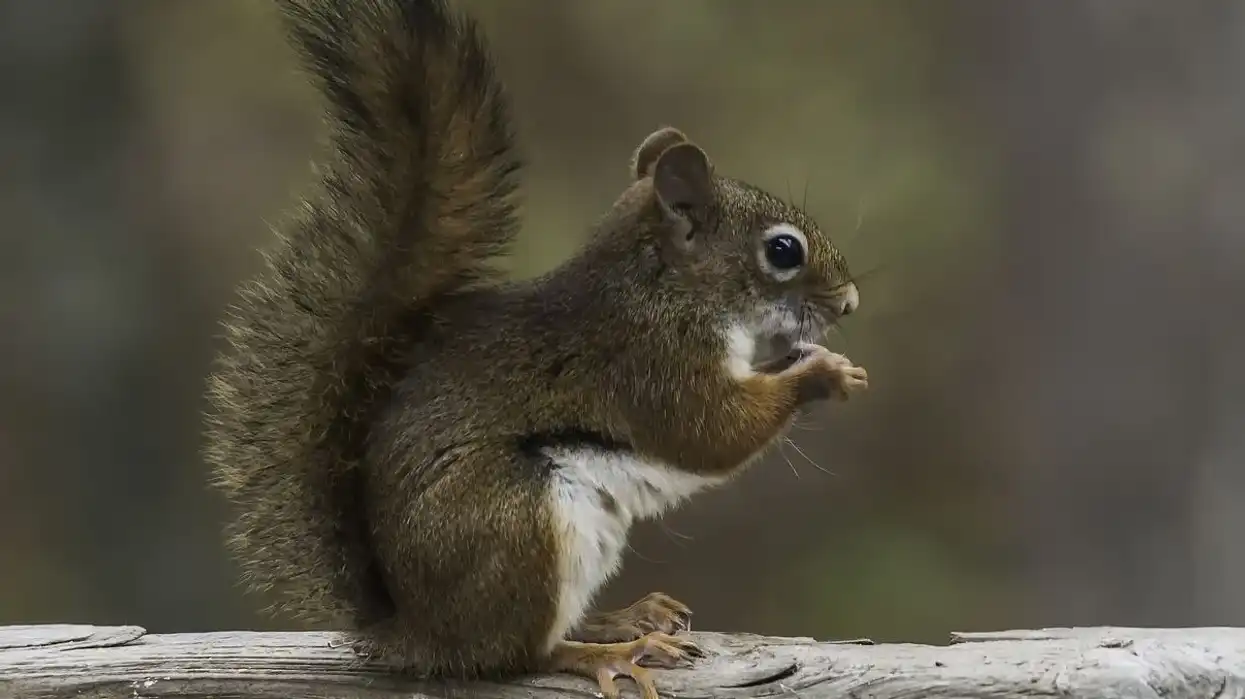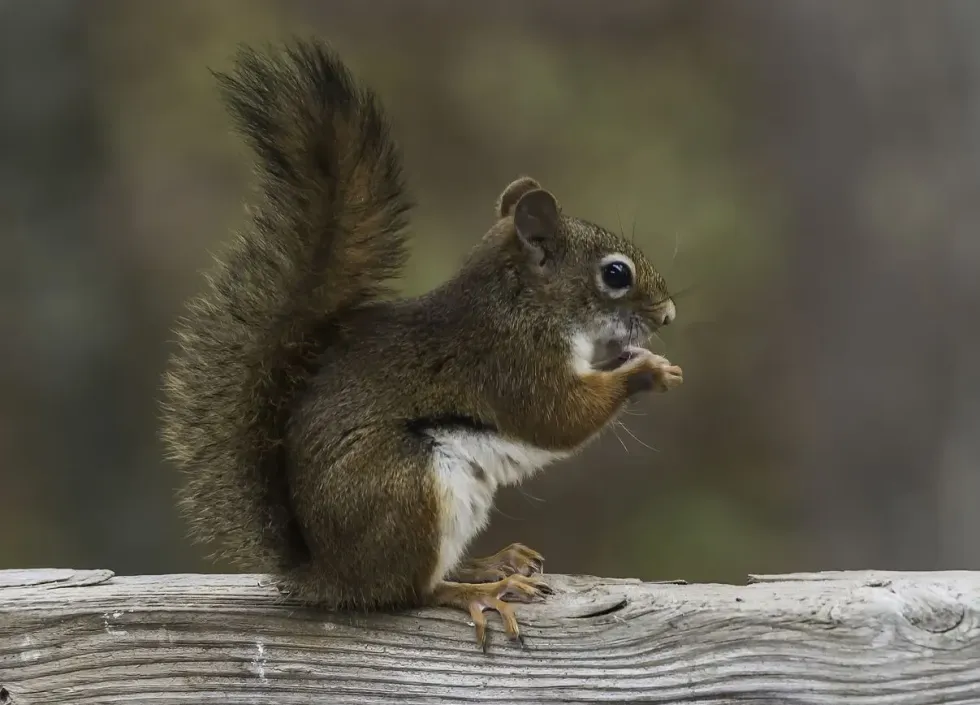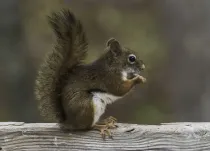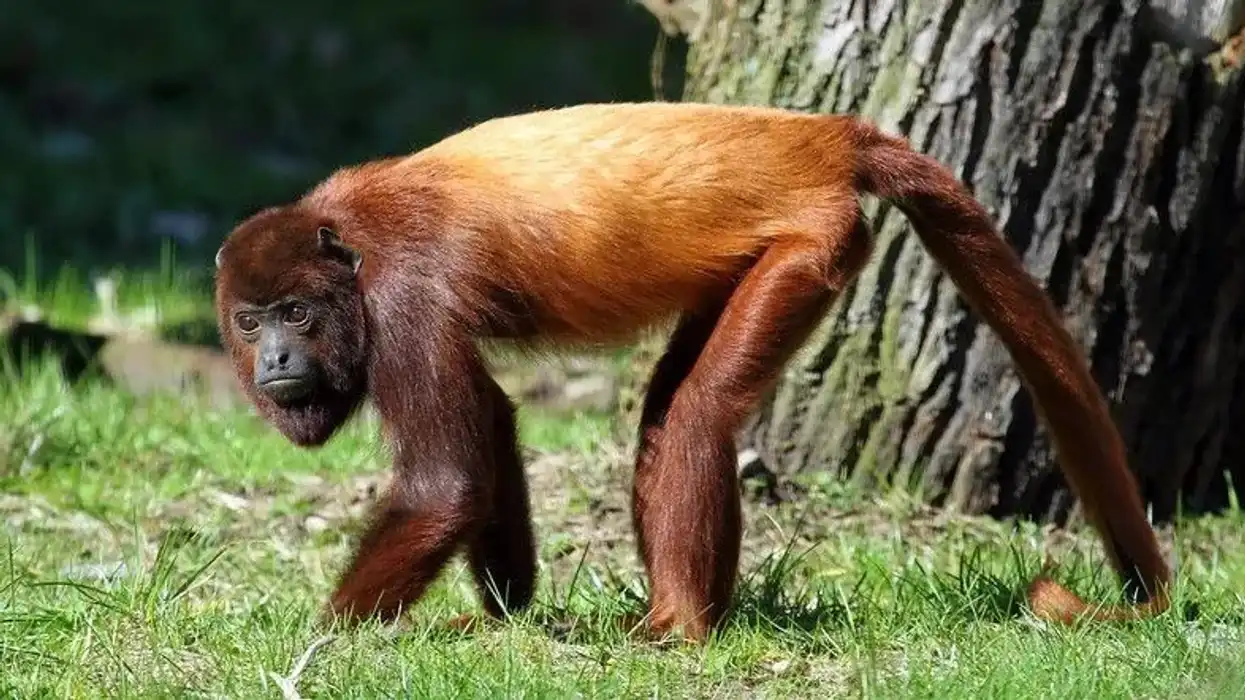Fun Red Squirrel Facts For Kids

Do you find squirrels extremely cute? You are in the right place to know about one of the most interesting species of squirrels known as the American Red Squirrel (Tamiasciurus hudsonicus).
Don't confuse them with their Eurasian counterpart, who is also known as the Red Squirrels (Sciurus vulgaris).
These squirrels mainly dwell in the coniferous forests of North America, and they are present in different parts of Canada and the United States. The favorite food of this species includes pine seeds, and they are known for stashing these seeds under the ground or in high piles.
Pine trees are a must in the habitat for these Red Squirrels, and they may even migrate due to their unavailability. The Red Squirrel, American variant, can be small, but they have an exquisite red or rust-gray fur covering.
Dwelling among trees and also on the ground, these squirrels are highly intelligent and can communicate amongst themselves with vocalizations and scents.
They do have a short lifespan because of the presence of many predators, but they do survive and are listed as of Least Concern in the International Union for Conservation of Nature Red List. Keep on reading to learn more about this interesting squirrel.
Also, check out Indian palm squirrel and flying squirrel facts to learn more about other species.
Red Squirrel Interesting Facts
What type of animal is a red squirrel?
An American Red Squirrel (Tamiasciurus hudsonicus) is a type of tree squirrel predominantly found in North America.
What class of animal does a red squirrel belong to?
The American Red Squirrel (Tamiasciurus hudsonicus) belongs to the class of Mammalia and to the order Rodentia. More than 25 subspecies of this squirrel are to be found in different parts of North America.
How many red squirrels are there in the world?
As they are a commonly found North American species of Red Squirrels, not much is known about their exact population that inhabit the continent.
Where does a red squirrel live?
The Red Squirrel, American variants, prefer to stay in coniferous forests, but they have been expanding their population to hardwood forests. The mammalian species of American Red Squirrels are found throughout North America. Some places where you may spot the squirrel include the Eastern United States, Canada, Blue Ridge Mountains, Rocky Mountains, and coastal areas of British Columbia.
What is a red squirrel's habitat?
American Red Squirrels like to live in forested areas with coniferous trees. They seldom have a population living in urban or suburban areas without the lack of coniferous trees near their vicinity. This species has a tolerance for living in cold or winter-prone areas.
However, the North American Red Squirrel isn't found on the Pacific coast, which is inhabited by the Douglas Squirrel. These animals usually live in the tree hollows of the forest. The species is also found in deciduous or mixed-coniferous forests.
Who do red squirrels live with?
The American Red Squirrel lives in nests made in tree hollows and they do share the whole forest space with other members of their population. The juveniles start acquiring territory before they face their first winter.
Some squirrels even stay close to their natal territory or they are even given 'middens' or food heaps by their mother. A huge chunk of the life of an American Red Squirrel depends on the availability of food.
How long does a red squirrel live?
The maximum lifespan of an American Red Squirrel is five to eight years. The most striking thing about these species is the infant survival rate which is quite low.
Only 22% of the young squirrels born in a breeding season are able to survive. One of the foremost reasons for this is the huge number of predators these squirrels may face in their lifetime. These squirrels may live longer in captivity than in the wild due to the absence of predators that are usually present in the habitat.
How do they reproduce?
The birth of new squirrels depends on the mating and breeding season. The frequency of mating also depends on the location of these tree squirrels.
The population hailing from Southern or Eastern sides may have multiple litters in a year. As we move Northwards, there the population tends to have a single litter per year, and the breeding season is usually in Spring.
Populations living in the Eastern United States usually have two litters per year, one in March and another in late July. Females go through estrus for only a day in the mating season, and they are spontaneous ovulators.
One female may engage in mating with up to 16 males in a single season. In some places, the reproduction and mating cycle of the females have got in sync with the presence of pine seeds.
The gestation period in females lasts for around 31-35 days, and they give birth to one to five babies. For some, the gestation period may go as low as 28 days.
However, some Red Squirrels may even have eight babies in a single litter. It takes a young Red Squirrel up to seven weeks before they venture out of the nests made in tree hollows.
They mature to have the body of a fully developed adult in just 125 days after birth. According to the Journal of Zoology, morphological changes take place quite fast in Red Squirrels.
The female Red squirrel usually forms the nest with dead branches inside trees. The most common nests are found in spruce trees, poplar trees, and walnut trees.
Males and females of Red Squirrels reach maturity at the age of one. The males do take part in caring for the young.
What is their conservation status?
According to the International Union for Conservation of Nature (IUCN) Red List, the conservation status of the American Red Squirrel is at Least Concern. Currently, they have enough food and trees to make themselves comfortable in the wild.
Red Squirrel Fun Facts
What do red squirrels look like?
The main difference between an American Red Squirrel and other tree squirrels is their distinct red color. The coloration is present in the male and female squirrels.
It can vary from being a deep red to a more rust-colored fur. Their belly and chest often have a paler fur of white or cream color with demarcations made by black stripes.
The black stripe is more distinct in the summer months than in the winter months. Red Squirrels do have a smaller body which enables them to move through the trees to hunt for pine seeds and other seeds.
You will find that their hind legs are strong and big while they have hand-like front paws that help them to hold seeds or other foods.
They also have small black eyes that are defined by white eyelids. When it comes to their tail, the American Red Squirrels do not have a big one, but it still looks quite fluffy.
The tail may even have a black stripe or band at its tip. The Red Squirrel goes through molting once in the spring and then again in the winter.
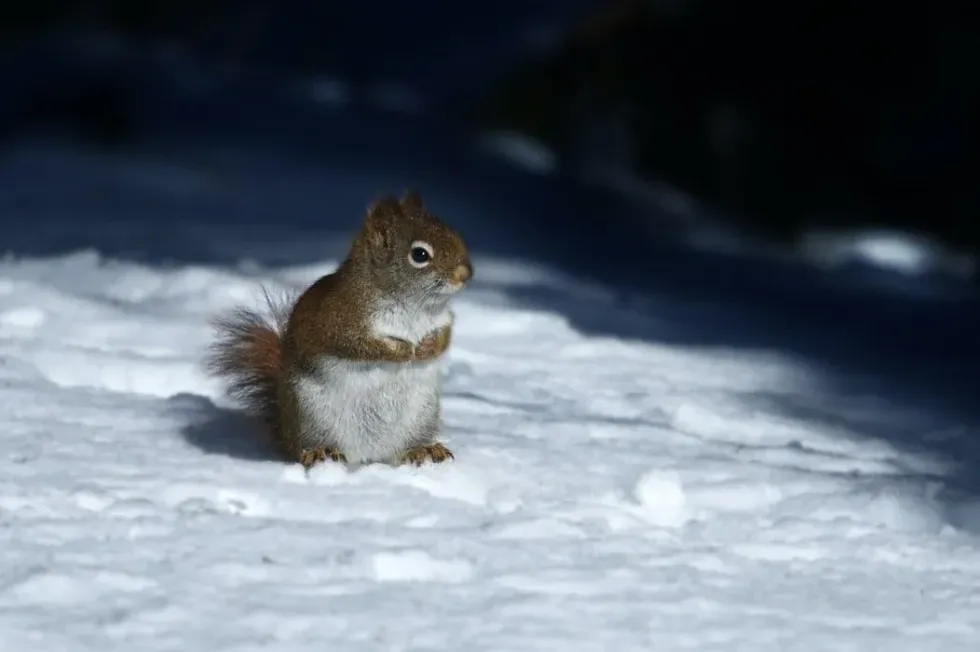
How cute are they?
A Red Squirrel is extremely cute because of its fluffy tail and small dainty hands. The species looks even cuter because of their small and dainty size.
How do they communicate?
One of the most interesting things about squirrels is their procedure of communication. It is the same with American Red Squirrels, who are quite intelligent themselves.
They have a well-developed sense of sight, smell, and hearing. The Red Squirrel may even get the hint of the smallest movements going on in their tree or nearby the tree. The Red Squirrel is also known for its call, which isn't aggressive.
The calls include the use of rattles, screeches, chirps, growls, and buzzes. Apart from vocalizations, they also use smell to communicate amongst each other.
How big is a red squirrel?
The average length of the Red Squirrel is around 11-14 in(28-35 cm) which includes their tail, so they aren't really that big. They are slightly smaller than the Eastern Grey Squirrel that has an average head-body length of 9-11 in (23-30 cm) and it doesn't include their tail.
How fast can a red squirrel run?
Tree squirrels are especially known for their fast speed and the long tail of a squirrel helps them in better balance. The fastest speed of a Red Squirrel is around 14 mph (22.5 kmph) which is quite swift for such a small animal. The fast speed of a Red Squirrel somewhat helps them to run away from predators.
How much does a red squirrel weigh?
The average weight of an American Red Squirrel is around 7.1-8.8 oz (200-250 g). The male can weigh a little more than the female Red Squirrels.
What are their male and female names of the species?
The male squirrels are known as boars and the female squirrels are known as sows.
What would you call a baby red squirrel?
An American Red Squirrel baby might be called a kit or a cub.
What do they eat?
American Red Squirrels have a diverse diet chart, and they eat many things. Their diet commonly includes pine cones, pine nuts, fruits, berries, tree bark, and mushrooms.
They may even make nests in only those areas where there is an ample amount of pine seeds. At times, the Red Squirrel may end up eating some insects or bird eggs, but that is quite rare.
The American Red Squirrel likes to hunt for green pine cones in the fall to bury them in the ground. They build up huge winter stashes of food to sustain them in the harsh weather.
Oftentimes, the nut or seed stashes are forgotten by the squirrels, and it gives rise to new trees. So, the Red Squirrels end up making their own habitat while planning for the winter months that they spend in the forests.
Are they dangerous?
No. Squirrels are not really dangerous when they are in the wild. However, they can behave aggressively towards humans if they feel threatened. Squirrels may even end up biting someone who they perceive as a threat.
Would they make a good pet?
Squirrels are highly intelligent and many people seem to have gotten a wish to keep them as pets. However, an American Red Squirrel is meant for the wild.
They like to live in coniferous trees, hunt for pine seeds, and make themselves comfortable in their tree nests. It's often illegal to keep the American Red Squirrels or even Grey Squirrels as pets.
Did you know...
It is a myth that Grey Squirrels kill Red Squirrels. No conclusive studies have shown that the two species compete with each other for any reason.
The American Red Squirrel mostly spends the winter months living in their nests made in trees to stay away from the cold winds and predators.
How rare is a red squirrel?
The American Red Squirrel isn't that rare as the species is found all over North America. According to the International Union for Conservation of Nature (IUCN) Red List, they are of Least Concern. They are far from being extinct.
Do red squirrels remember humans?
Yes, there have been instances where squirrels have remembered humans. Squirrels are especially known for identifying those people who tend to give them food or refill their feeder. Even wild squirrels can be well trained into knowing people. Along with that squirrels tend to have really good memories.
Here at Kidadl, we have carefully created lots of interesting family-friendly animal facts for everyone to discover! Learn more about some other mammals including fox squirrel, or Siberian tiger.
You can even occupy yourself at home by drawing one on our red squirrel coloring pages.
We Want Your Photos!
More for You
See All
Bachelor of Arts specializing in Journalism and Mass Communication, Postgraduate Diploma in Sports Management

Moumita DuttaBachelor of Arts specializing in Journalism and Mass Communication, Postgraduate Diploma in Sports Management
A content writer and editor with a passion for sports, Moumita has honed her skills in producing compelling match reports and stories about sporting heroes. She holds a degree in Journalism and Mass Communication from the Indian Institute of Social Welfare and Business Management, Calcutta University, alongside a postgraduate diploma in Sports Management.
Bachelor of Law

Abdulqudus MojeedBachelor of Law
A versatile professional with a passion for creative writing and technology. Abdulqudus is currently pursuing his Bachelor of Law from the University of Lagos and has experience as a tutor, intern assistant, and volunteer. He possesses strong organizational skills and is a detail-oriented person.
Disclaimer
1) Kidadl is independent and to make our service free to you the reader we are supported by advertising. We hope you love our recommendations for products and services! What we suggest is selected independently by the Kidadl team. If you purchase using the Buy Now button we may earn a small commission. This does not influence our choices. Prices are correct and items are available at the time the article was published but we cannot guarantee that on the time of reading. Please note that Kidadl is a participant in the Amazon Services LLC Associates Program, an affiliate advertising program designed to provide a means for sites to earn advertising fees by advertising and linking to Amazon. We also link to other websites, but are not responsible for their content.
2) At Kidadl, we strive to recommend the very best activities and events. We will always aim to give you accurate information at the date of publication - however, information does change, so it’s important you do your own research, double-check and make the decision that is right for your family. We recognise that not all activities and ideas are appropriate for all children and families or in all circumstances. Our recommended activities are based on age but these are a guide. We recommend that these ideas are used as inspiration, that ideas are undertaken with appropriate adult supervision, and that each adult uses their own discretion and knowledge of their children to consider the safety and suitability. Kidadl cannot accept liability for the execution of these ideas, and parental supervision is advised at all times, as safety is paramount. Anyone using the information provided by Kidadl does so at their own risk and we can not accept liability if things go wrong.
3) Because we are an educational resource, we have quotes and facts about a range of historical and modern figures. We do not endorse the actions of or rhetoric of all the people included in these collections, but we think they are important for growing minds to learn about under the guidance of parents or guardians.
